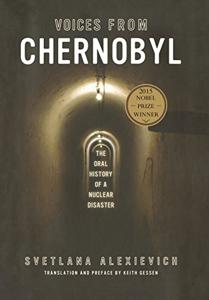
Want to learn the ideas in Voices From Chernobyl better than ever? Read the world’s #1 book summary of Voices From Chernobyl by Svetlana Alexievich, Keith Gessen here.
Read a brief 1-Page Summary or watch video summaries curated by our expert team. Note: this book guide is not affiliated with or endorsed by the publisher or author, and we always encourage you to purchase and read the full book.
Video Summaries of Voices From Chernobyl
We’ve scoured the Internet for the very best videos on Voices From Chernobyl, from high-quality videos summaries to interviews or commentary by Svetlana Alexievich, Keith Gessen.
1-Page Summary of Voices From Chernobyl
Overall Summary
Voices from Chernobyl (1997) is a collection of interviews with survivors and witnesses to the 1986 nuclear disaster. It’s divided into three parts: Land of the Dead, Land of the Living, and Amazed by Sadness. The voices are mostly those who were there on that fateful day in April 1986. There are some monologues and others that include multiple voices speaking at once about what they experienced ten years after the event. Some focus on what happened then while others talk about how it affected their lives now ten years later. One such person was Svetlana Alexievich, who won a Nobel Prize for Literature in 2015 for her work documenting events like this one through oral histories.
In the first part of this book, Alexievich discusses the hundreds of thousands of people who have been affected by nuclear radiation. Despite the dangers, many continue to live in contaminated areas and consume products from these regions. She interviews Lyudmila Ignatenko, a woman whose husband was exposed to high levels of radiation while responding to an accident at Chernobyl. He eventually died after weeks on end with his wife wiping radioactive particles off his face until he finally passed away. Two months later, she gave birth to a baby girl who died within four hours due to heart and liver complications caused by intense radiation exposure (28 roentgens).
Similar accounts of the Chernobyl disaster are told over and over. In the second section, “The Land of the Living,” Alexievich’s interviews focus on how people coped with the aftermath. No one was prepared for such a lingering effect from this tragedy; they were either misled about or unaware of what would happen after it happened. The authorities did little to help those affected by it; widespread corruption and incompetence followed. People trusted their government to protect them but now they feel betrayed by that trust because there is still no solution in sight even though many years have passed since then. Many people died as a result of radiation poisoning, while others suffered from cancer due to radiation exposure and some had genetic damage inflicted upon them which will be passed down through future generations, too.
In the third section, “Amazed by Sadness,” Alexievich gives voice to those who feel stigmatized as a “Chernobylite.” Additional interviewees include children at the time of the blast who have since grown up, “liquidators”, soldiers responsible for extinguishing nuclear fires, village peasants, doctors, teachers, journalists and scientists. A hunter is sent to exterminate contaminated housecats and dogs. Liquidators voice their resentment over an incompetent Soviet government that dispatched them to clean up the mess. Russian refugees from Tajikistan fled Chernobyl because they would rather live in a contaminated zone of radiation than face men with guns in their war-torn homeland. Helicopter pilots and unprotected citizens are also given a voice; deformed children; black marketers who sold contaminated equipment; useless bureaucrats; scientists and health officials who tried to warn of impending doom are all given a voice.
The Chernobyl disaster is often compared to WWII, in that many people affected by the radiation are directly linked with war. Whether they were forced into evacuations or had their land and property taken away from them, there are many parallels between the two events. The invisible enemy makes it hard to win this war because there’s no way of knowing if you’re safe. One person said “Chernobyl is like the war of all wars.” People who stayed behind called themselves “self-settlers” because they believed staying was safer than leaving. In addition, some survivors also link Chernobyl to Communism after it fell shortly after the nuclear devastation took place. An idealistic engineer lost faith in Communism when he saw how his country reacted to such a devastating event that changed everything about their lives forever. Many people still live with these effects today as seen through an interview with a loving wife whose husband suffers from cancer caused by radiation exposure at Chernobyl (the same thing happened at Hiroshima).





